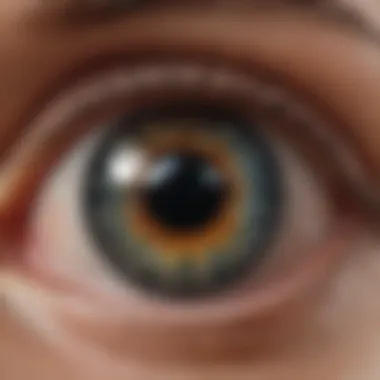Glaucoma and Disability Benefits: Qualification Insights


Intro
Glaucoma represents a group of eye conditions that can lead to irreversible vision loss. It is a major public health issue, impacting millions worldwide. The complexity of glaucoma not only lies in its medical management but also in its implications for individuals seeking disability benefits. For those affected, understanding qualification criteria for these benefits is crucial. This section delineates the intricate relationship between glaucoma, disability, and the requirements necessary for securing financial assistance through disability programs.
The eligibility for disability benefits due to glaucoma is not straightforward. It hinges on a combination of medical documentation, legal standards, and the severity of the condition. Individuals facing visual impairment from glaucoma often encounter challenges in navigating the disability claims process. Thus, a thorough exploration of the criteria set forth by disability programs is essential for empowering those in need of support.
In the upcoming sections, we will unpack the qualification criteria for disability benefits associated with glaucoma. By doing so, we aim to clarify the legal expectations and medical evidence required to substantiate a claim. This knowledge is vital for affected individuals, legal professionals, and healthcare providers alike as they work together to address the challenges posed by this condition.
Prelude to Glaucoma
Glaucoma is a significant eye condition that affects many individuals globally. Understanding this disorder is crucial, especially when discussing the intersection of glaucoma with disability benefits. It is a complex topic that has implications not just for healthcare but also for legal rights and access to benefits.
Grasping the nature and implications of glaucoma can help patients navigate their medical and legal options. Those who suffer from this condition may experience vision loss, which can severely impact daily activities. As such, knowing the types, symptoms, and risks associated with glaucoma is vital for anyone considering a disability claim.
This section serves as an overview of glaucoma, setting the stage for deeper discussions on how this condition affects individuals' rights to disability benefits. This includes pinpointing specific qualification criteria and the importance of having adequate medical documentation.
Understanding both glaucoma and the associated disability benefits can empower individuals to make informed choices regarding their health and ensure they receive necessary support.
Understanding Disability Benefits
Understanding disability benefits is crucial for individuals dealing with glaucoma, as these benefits can significantly impact their quality of life. Disability benefits serve as a financial safety net for those unable to work due to a medical condition. This section explores the definition of disability and the various types of benefits available, which can provide essential support for managing the costs associated with glaucoma care and treatment.
Definition of Disability
Disability, in the context of benefits, refers to a physical or mental impairment that severely limits a person's ability to perform daily tasks or work. For those experiencing glaucoma, the specifics can vary, with vision loss being a common issue. To qualify for disability benefits, applicants must demonstrate that their condition impacts their employability, significantly reducing their income potential.
Types of Disability Benefits
There are different types of disability benefits available in the United States, specifically Social Security Disability Insurance (SSDI) and Supplemental Security Income (SSI). Each serves distinct populations and has various eligibility requirements. Understanding these differences is essential for applicants seeking support.
Social Security Disability Insurance (SSDI)
Social Security Disability Insurance (SSDI) is a federal program that provides financial assistance to individuals who have paid into Social Security through their employment. A significant aspect of SSDI is that it is based on work credits accrued over a person's career. This program is particularly beneficial for those who have held jobs and contributed to Social Security before becoming disabled.
A key characteristic of SSDI is that it offers monthly cash benefits along with access to Medicare after 24 months of being disabled. This can be a vital resource when managing ongoing medical expenses, such as treatments for glaucoma. On the downside, SSDI has strict eligibility requirements, and proving the extent of disability can be challenging. The evaluation process often requires extensive medical documentation.
Supplemental Security Income (SSI)
Supplemental Security Income (SSI) is designed for individuals with limited income or resources, regardless of their work history. SSI offers a monthly stipend to help meet basic needs, including food, clothing, and shelter. Its primary aim is to aid those in financial hardship who cannot work due to disability.
The distinctive feature of SSI is that it is means-tested, meaning eligibility is based on financial need rather than work history. This is an advantage for those who might not have sufficient work credits to qualify for SSDI. However, the payment amounts may be adjusted based on other income or living arrangements, which can limit the total benefits received.
Understanding the nuances of these benefits can help secure financial stability and address the challenges posed by glaucoma.
Glaucoma's Impact on Daily Life
The impact of glaucoma on daily life is significant and multifaceted. This section examines how the condition affects individuals beyond mere visual acuity. Understanding these impacts helps to highlight the necessity for appropriate support and benefits.
Visual Impairments Associated with Glaucoma
Glaucoma can lead to various visual impairments that hinder daily activities and affect quality of life. These impairments include peripheral vision loss and difficulties with contrast sensitivity, both of which present unique challenges.


Peripheral Vision Loss
Peripheral vision loss is a common effect of glaucoma. This type of vision damage contributes to an impaired ability to perceive objects outside of central vision. When patients lose their peripheral vision, they may experience challenges in situations that require a wider field of view, such as driving or navigating crowded spaces. This loss is detrimental because it affects spatial awareness, increasing the risk of accidents and falls.
The characteristic of peripheral vision loss is that it often progresses silently. Many individuals may not notice these changes until they become significant. This makes early detection and understanding of the condition crucial for prevention and management. It is beneficial to include this condition's implications in discussions on disability because it directly affects how people engage with their surroundings.
Difficulty with Contrast Sensitivity
Another aspect related to visual impairments in glaucoma is difficulty with contrast sensitivity. Individuals liable to this sensitivity find it challenging to distinguish between objects and their backgrounds, especially in low-light conditions. This issue complicates tasks such as reading signs or recognizing faces in dimly lit environments.
The key characteristic of contrast sensitivity loss is its potential to lead to reduced visibility in situations that many take for granted. For instance, a person with impaired contrast sensitivity may struggle to cross the street at night. This can lead to heightened anxiety when performing daily tasks. It is crucial to understand this aspect when discussing disability benefits, as it demonstrates the impact of glaucoma on a person's ability to function in various environments.
Psychosocial Effects
The psychosocial effects of glaucoma can be profound. Beyond visual challenges, individuals may experience anxiety, depression, and social isolation as they cope with their condition. Adaptation to vision loss can be a demanding process. Patients may feel fear or frustration when trying to maintain independence.
Social interactions might change as well. The loss of visual capability can stop individuals from participating in activities they once enjoyed. The emotional burden can lead to withdrawing from family and friends. Acknowledge these facets of glaucoma when assessing the need for supportive measures or disability benefits. Open discussions about mental health should accompany any assessment of visual impairments.
Understanding these elements not only aids those affected by glaucoma but also informs healthcare providers and legal professionals about the broader implications of this disease on daily living.
Eligibility Criteria for Disability Claim
The eligibility criteria for a disability claim related to glaucoma are critical to comprehend for individuals affected by this condition. Understanding these criteria can significantly influence the outcome of an application for disability benefits. Key elements include the medical documentation required, which helps establish the severity of the impairment. Additionally, an assessment of functional limitations is needed to demonstrate how glaucoma affects daily activities. For eligible individuals, these benefits may provide crucial financial support and access to necessary resources for managing their condition.
Using clear guidelines for eligibility can streamline the application process and reduce the chances of denial, thus presenting a pathway towards obtaining the needed assistance.
Medical Documentation Requirements
When applying for disability benefits, the medical documentation is a foundational element. This requirement can often be divided into two main aspects: ophthalmologist's reports and symptom descriptions.
Ophthalmologist's Reports
Ophthalmologist's reports serve as an essential component in the application for disability benefits concerning glaucoma. These reports typically include a comprehensive evaluation of the patient's visual capabilities and the progression of the disease. A key characteristic of these reports is that they provide objective measurements of eye health, facilitating clear communication on the severity of the condition. This adds credibility to the application, making it a common choice for foundational documentation in such claims.
A unique feature of ophthalmologist's reports is their standardization, which can be advantageous. The detailed tests and assessments conducted—such as visual field tests and intraocular pressure measurements—offer quantifiable data. This data supports the claim and often aligns well with the guidelines set by the Social Security Administration. However, if the report is vague or lacks detail, it may not fulfill the requirements necessary for the claim, underscoring the importance of thoroughness.
Symptom Descriptions
Symptom descriptions provide a personalized narrative of the individual's experience with glaucoma. They emphasize how the disease manifests in daily life and how it restricts various activities. One of the main characteristics of symptom descriptions is their ability to portray the qualitative aspects of the individual's impairments. This form of documentation is a beneficial complement to the more technical ophthalmologist's reports.
The unique feature of symptom descriptions lies in the subjective experience they convey. They can address areas like difficulty in recognizing faces, challenges in navigating environments, or the emotional burden of living with vision loss. These insights can make the application more relatable and comprehensive. However, the challenge with symptom descriptions is that they can be viewed as less objective compared to clinical reports, which highlights the necessity for applicants to balance both objective and subjective documentation for a stronger claim.
Functional Limitations Assessment
Functional limitations assessment examines how glaucoma compromises the ability to perform daily activities. This assessment may consider various aspects such as mobility, self-care, and social interaction. Evaluators often look for specific examples of how vision loss impacts these areas.
The importance of this assessment is its ability to connect the medical condition to real-life challenges faced by individuals. It not only supports the claim for financial benefits but also underscores the broader impact of glaucoma on one's quality of life. This type of assessment can require input from both healthcare providers and the individual, ensuring a complete picture is presented in the claim.
Legal Standards for Glaucoma Claims
Understanding the legal standards for glaucoma claims is essential for those seeking disability benefits. These standards set the framework for evaluating whether an individual qualifies for assistance based on the impact of glaucoma on their daily life and ability to function. The Social Security Administration (SSA) provides clear guidelines that must be adhered to when filing a claim, which helps in streamlining the evaluation process.


Why Legal Standards Matter
Legal standards ensure that each claim is assessed fairly and consistently. By providing specific criteria, the SSA avoids arbitrary decisions and helps applicants understand what is needed to validate their claims. Compliance with these standards significantly improves the chances of a claim being approved, especially for complicated conditions like glaucoma.
Social Security Administration Listings
The SSA maintains a list of medical conditions that may qualify for disability benefits, known as the Listings of Impairments. Glaucoma is specifically addressed under these listings, which require detailed medical evidence to support a claim.
To qualify via the SSA listings for glaucoma, applicants must provide:
- A detailed description of their visual impairments caused by glaucoma.
- Medical documentation from an ophthalmologist, including test results and treatment history.
- Evidence of how the condition affects day-to-day functionality, particularly in visual tasks.
Inclusion in these listings is crucial because it simplifies the approval process by showing that a recognized medical condition significantly limits one's ability to perform work-related activities.
Burden of Proof in Disability Claims
In the context of disability claims, the burden of proof lies with the applicant. This means that individuals must provide sufficient evidence to demonstrate that their glaucoma severely hinders their ability to work.
The proof can include:
- Medical records showcasing ongoing treatment and prescribed medications.
- Detailed accounts of symptoms, especially those affecting vision, like peripheral vision loss.
- Assessments from healthcare providers that outline functional limitations due to glaucoma.
If the applicant fails to provide adequate proof, the claim may be denied. It is essential to understand that this process can be complex, and having comprehensive documentation can make a significant difference in the outcome of a claim.
"The process for proving disability claims is not only tedious but requires accurate and thorough medical evidence."
Challenges in Obtaining Disability for Glaucoma
The process of securing disability benefits for glaucoma can be arduous. Many individuals affected by this condition face unique challenges that make qualification difficult. Understanding these challenges is crucial for applicants, healthcare providers, and legal professionals. It helps to navigate the complexities of disability claims and better prepare for potential hurdles along the way.
Common Reasons for Denial
Several reasons frequently lead to the denial of disability claims related to glaucoma. Understanding these can help applicants address potential issues proactively.
- Insufficient Medical Evidence: Claims often get rejected due to inadequate documentation from healthcare providers. Applicants must provide comprehensive ophthalmological reports that detail the severity of their condition. If the documentation lacks detail or fails to connect the condition to functional limitations, the claim may be denied.
- Failure to Meet Specific Criteria: The Social Security Administration (SSA) has specific criteria listed under its guidelines for vision impairments. If an individual's glaucoma does not meet these criteria, the claim can be denied. For example, if peripheral vision loss is not adequately documented, benefits might be out of reach.
- Inconsistent Reports: Any discrepancies in medical records, like differing accounts of symptoms or visual acuity between visits, can raise red flags. Insurers may view inconsistent reports as a sign that the condition is not as debilitating as claimed.
- Lack of Treatment Compliance: Applicants are expected to follow prescribed treatments. Not adhering to medical advice or failing to attend follow-up appointments can result in denials.
"Applicants should ensure that their medical documentation is thorough and consistent. Careful preparation helps minimize the risk of denial."
Appeal Process After Denial
Facing a denial can be disheartening, but it is not the end of the road. The appeal process provides an opportunity to contest the decision and strengthen the case. Here are key steps involved in this process:
- Understanding Denial Reasons: The first step in appealing a denial is to carefully examine the explanation provided by the SSA. This helps pinpoint the exact reasons for denial and guide the next steps in securing the needed documentation.
- Gathering Further Evidence: In many cases, the appeal will require additional medical evidence. Engage with healthcare professionals to obtain updated reports that reflect any changes in the condition and more clearly illustrate its impact on daily life.
- Submitting the Appeal: The appeal must be formally submitted within the designated timeframe. This can typically be done online or by mail. Ensure all required documentation is included to avoid further delays.
- Hearing Before an Administrative Law Judge: If the appeal is unsuccessful, applicants can request a hearing. Here, they will have the opportunity to present their case personally. Legal representation can be beneficial at this stage to articulate the nuances of the case effectively.
- Navigating the Decision: The decision made by the Administrative Law Judge can be either favorable or unfavorable. If denied again, further appeals to higher authorities or federal court may be considered.
Understanding these challenges and the associated processes can empower those affected by glaucoma. It can also facilitate better dialogue between patients and healthcare providers, which is essential for successful disability eligibility.
The Role of Healthcare Providers
Healthcare providers play a vital role in the process of obtaining disability benefits for patients suffering from glaucoma. Their expertise is not only crucial in diagnosing and managing the disease but also in navigating the complex paperwork and requirements necessary for disability claims. Effective collaboration between healthcare providers and patients enhances the quality of the documentation submitted, ultimately impacting the success of disability applications.
The healthcare community must recognize their responsibility in this context. The better the documentation, the more likely it is that essential details regarding the patient's condition are understood by those reviewing claims. As a crucial link in this system, healthcare providers must have a comprehensive understanding of how glaucoma affects their patients' lives and functionality.
Collaboration in Documentation


Collaboration between patients and healthcare providers is essential for effective documentation. Healthcare providers must clearly articulate the extent of the impairment caused by glaucoma in their reports. This involves detailing the patient's symptoms, like vision loss or difficulty in light adjustment. When medical reports lack clarity or specificity, it can lead to delays or denials in the disability claim process.
Some key elements of this collaboration include:
- Regular follow-ups: This helps in monitoring the progression of the disease and documenting any changes in the patient’s condition.
- Comprehensive examinations: Providers must conduct detailed evaluations and tests, ensuring all possible impacts of glaucoma are recorded.
- Clear communication: Providers should ensure that patients understand the importance of providing complete information regarding their symptoms and struggles.
"A well-documented medical history significantly strengthens a patient's case for disability benefits."
Through this collaboration, healthcare practitioners can be effective advocates for their patients. They must represent the nuances of how glaucoma impacts daily functioning while ensuring that documentation is both thorough and accurate.
Importance of Thorough Evaluations
Thorough evaluations by healthcare providers are critical in establishing the validity of disability claims related to glaucoma. The depth of an evaluation can influence the decision-making process of the Social Security Administration. Evaluations must encompass aspects beyond visual acuity; they should also assess how the condition affects various daily activities, emotional well-being, and overall quality of life.
Key factors in thorough evaluations include:
- Detailed medical history: A comprehensive overview of the patient’s medical history, including the onset and progression of glaucoma, is essential.
- Functional assessments: Taking into account the patient’s day-to-day activities helps in understanding the practical implications of their visual impairment.
- Attentiveness to additional conditions: Many patients may have co-existing health issues, and these should not be overlooked in evaluations.
Thorough evaluations serve to present a complete picture of how glaucoma affects the patient. They are crucial for establishing eligibility for disability benefits and should be approached with an awareness of their significance.
In summary, healthcare providers are indispensable in the process of claiming disability benefits for glaucoma. Through their knowledge and diligent work, they help patients articulate their challenges effectively, ultimately guiding them toward receiving the support they need.
Future Directions in Disability Claims
Understanding the future directions in disability claims, particularly regarding glaucoma, is critical for stakeholders including patients, healthcare providers, and policymakers. The landscape of disability benefits is evolving, influenced by innovations in medical research and shifts in legislative frameworks. These developments have far-reaching implications for how individuals with glaucoma may qualify for assistance.
Potential Legislative Changes
Legislation plays a vital role in shaping the eligibility criteria for disability benefits. Future reforms could focus on inclusion policies that consider the wide spectrum of visual impairment caused by glaucoma. Current standards primarily rely on specific visual acuity measurements, potentially excluding individuals with significant peripheral vision loss.
There is a growing advocacy for more nuanced legislative approaches that might include:
- Comprehensive assessments of visual field loss, ensuring that various degrees of impairment are recognized.
- Increased awareness of the psychosocial impacts of glaucoma, beyond just physical limitations, allowing for a broader understanding of disability.
- Flexibility in eligibility criteria, which could adapt to individual patient needs and circumstances, rather than one-size-fits-all standards.
"The evolution of legislation surrounding disability claims is not just a bureaucratic need; it reflects our society's commitment to inclusivity and understanding health conditions."
Emerging Research on Glaucoma
Emerging research offers promising insights into the mechanisms and impacts of glaucoma, which may influence future disability claims. Understanding the biological and psychological dimensions of the disease can lead to better evaluation methods. Current studies focus on:
- Neuroprotective treatments, which aim to preserve vision and potentially alter the course of the disease. If successful, this could change the way functional impairment is assessed.
- Psychosocial studies that examine how individuals cope with visual impairments, informing policymakers on the associated daily challenges.
- Technological advancements, such as artificial intelligence in diagnostics, may provide more accurate assessments of vision loss, leading to better patient outcomes and refined claim processes.
Ultimately, as research evolves, so too could the criteria that determine eligibility for disability benefits. The integration of scientific insight into policy decisions is crucial for ensuring that the rights of those affected by glaucoma are fully recognized and supported.
Closure
Understanding the criteria for disability benefits in cases of glaucoma is of paramount importance. The intricacies of the legal and medical landscapes require that individuals seeking assistance possess a solid understanding of these frameworks. This article has outlined essential elements such as visual impairments related to glaucoma, necessary documentation, and the challenges that can arise during the application process.
Summarizing Key Points
In summary, this article has emphasized several crucial aspects:
- Definition of Glaucoma: We explored what glaucoma is and its various types to underscore how they might affect one's eligibility for benefits.
- Eligibility Criteria: We discussed necessary medical documentation and assessments required for a claim.
- Legal Standards: The significance of understanding the Social Security Administration's listings was highlighted, showing how these can affect the outcome of claims.
- Challenges in Obtaining Benefits: Recognizing common reasons for claim denial can aid applicants in preparation.
- Role of Healthcare Providers: A thorough collaboration with healthcare professionals can significantly impact the chances of approval.
- Future Directions: Additionally, emerging research and potential changes in legislation might reshape how glaucoma claims are processed in the future.
Encouraging Comprehensive Review
A comprehensive review is vital for anyone considering applying for disability benefits due to glaucoma. Applicants must gather detailed documentation from qualified healthcare providers, including ophthalmologists. Clear symptom descriptions and functional limitations assessments should also be included.
Moreover, understanding the entire process surrounding disability claims can prevent missteps that could lead to denial. By being well-informed, individuals can advocate for themselves more effectively, enhancing their prospects of securing necessary benefits. Regular follow-ups on emerging legal standards and medical advancements are recommended to stay current.



